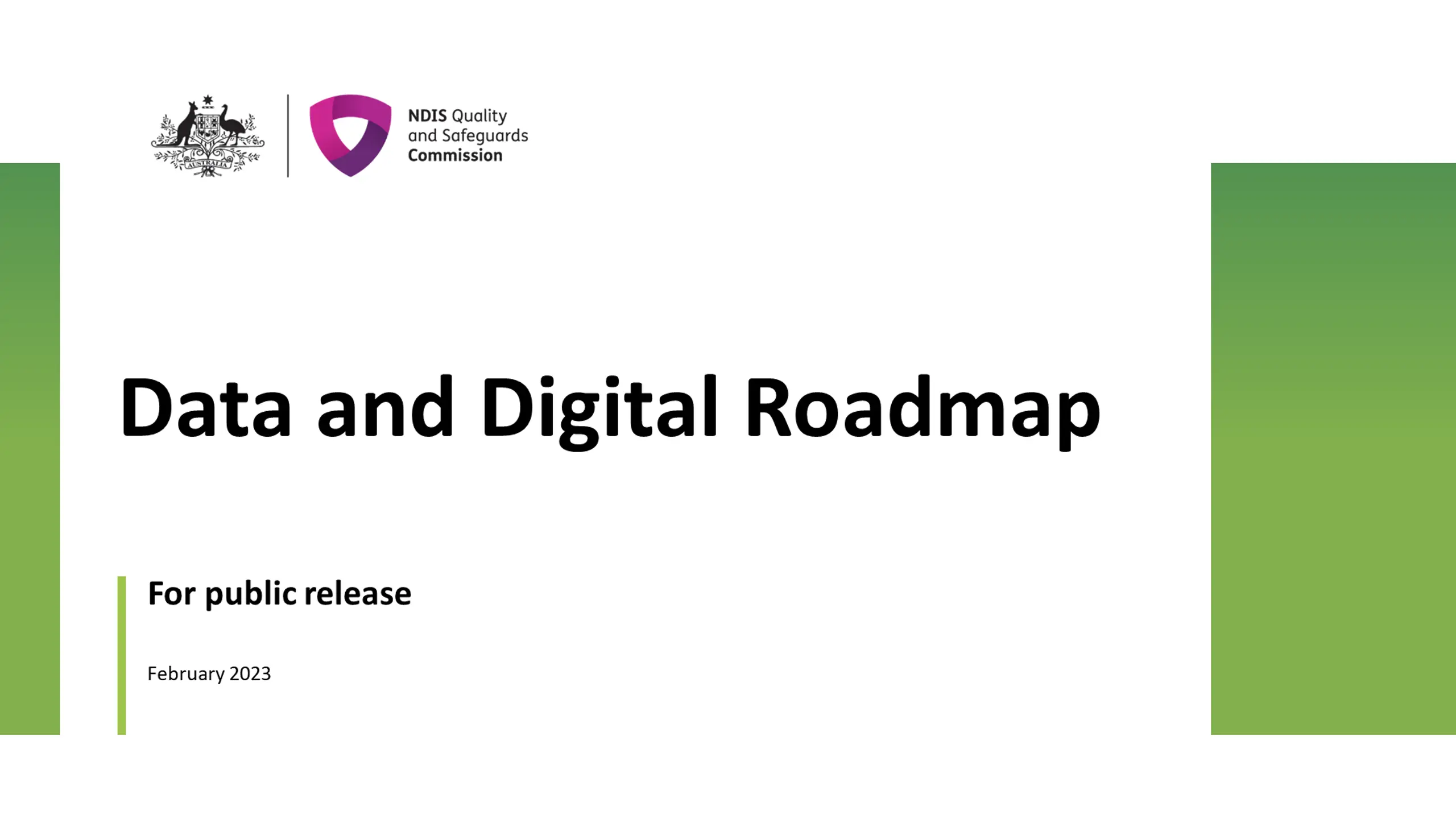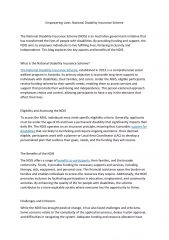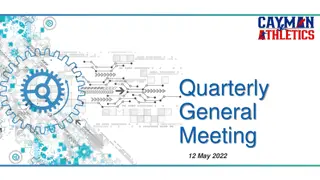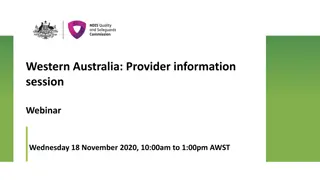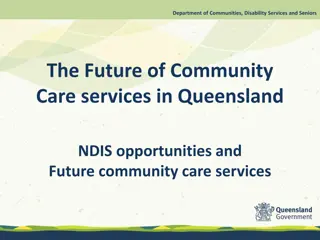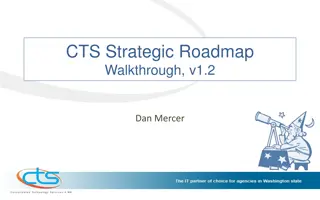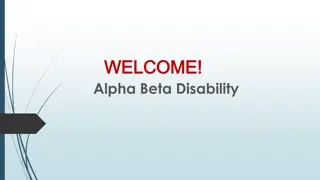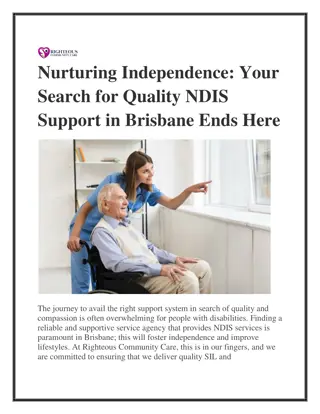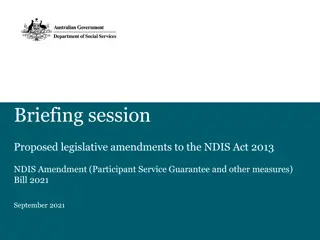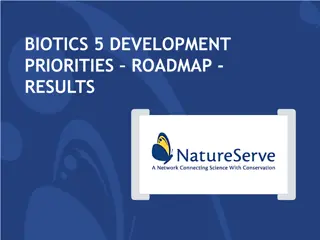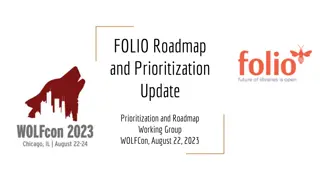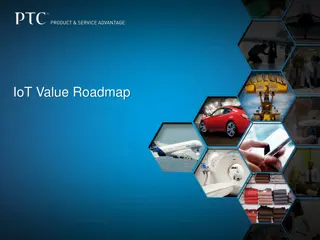Data and Digital Roadmap for NDIS Commission
This roadmap outlines the data and digital approach of the NDIS Quality and Safeguards Commission to enhance participant rights, improve provider quality, and foster a thriving market. It supports the Commission's vision to become a purpose-centered regulator.
Download Presentation

Please find below an Image/Link to download the presentation.
The content on the website is provided AS IS for your information and personal use only. It may not be sold, licensed, or shared on other websites without obtaining consent from the author.If you encounter any issues during the download, it is possible that the publisher has removed the file from their server.
You are allowed to download the files provided on this website for personal or commercial use, subject to the condition that they are used lawfully. All files are the property of their respective owners.
The content on the website is provided AS IS for your information and personal use only. It may not be sold, licensed, or shared on other websites without obtaining consent from the author.
E N D
Presentation Transcript
Data and Digital Roadmap For public release February 2023
Background to the project The NDIS Quality and Safeguards Commission (the Commission) aspires to become a contemporary, purpose-centred regulator that focuses on NDIS participants as part of all organisational activities. The Commission Operating System (COS), was developed prior to the Commission being implemented, to execute many of the Commission s core functions. A range of other tools were also developed at this time and remain within the Commission s ICT environment. Since the Commission commenced operations, there has been significant growth in the number of NDIS participants, the number of NDIS providers, and increased complexity within the market. This had led to changed requirements for the Commission s ICT tools and environment. It is recognised that the Commission s Data and Digital environment is a key enabler of the Commission s purpose and vision. The Data and Digital Roadmap will enable informed decision making in relation to investment, and its delivery will support the Commission s maturity as a regulator. 2
The Data and Digital Roadmap is a key enabler for the Commission to realise its vision and purpose Strategic Plan 2022-2027 The NDIS Commission works with people with disability, the NDIA, governments and the sector who together deliver the National Disability Insurance Scheme Source: NDIS Commission Strategic Plan 2022-2027 3
Data and digital approaches will influence the impact the Commission has on the rights of participants, quality of providers and the market Impact 1: The rights of people with disabilities Impact 2: Quality providers and workers Impact 3: Thriving, diverse markets Lower regulatory burden in identified areas of risk More complaints resolved in a timely manner Increased quality of providers Higher satisfaction, experience and trust in the Commission for participants and their supporters Systemic issues identified and effectively addressed Ensuring only quality providers are allowed to be registered Better understanding among providers regarding what quality and safety means for participants Greater access to, and choice of, skilled workers Newly registered providers actively delivering services within three months 4 Source: NDIS Commission Strategic Plan 2022-2027, NDIS Commission Corporate Plan 2022 23
The Data and Digital Roadmap is designed to enable the Commission's vision Data and Digital Roadmap Framework Overarching vision defines why the Data and Digital Roadmap exists People with disability achieve their aspirations Why Providers encouraging safe, innovative, high quality support provision Workers promoting a safe and competent workforce NQSC Staff develop, attract and retain staff with the right skills and attributes Outcomes for stakeholders Participants supporting and empowering people with disability Data and Digital Pillars The data and digital pillars that drive outcomes for stakeholders Positive participant and provider experiences Digital Insight and intelligence capability Empowered Commission staff Robust data governance leadership and agility What The enablers are the foundation upon which the pillars are built Data and Digital Enablers System Architecture Data and Digital Competencies How The roadmap horizons deliver outcomes for stakeholders Roadmap Horizon 1 Improved efficiency and experience Roadmap Horizon 2 Connected datasets and records Roadmap Horizon 3 Improved regulatory outcomes 5
The risk of not transforming data and digital across the Commission is significant The cost of not transforming Impact of delivering Data and Digital Roadmap Ability to safeguard participants and achieve Commission Increasing manual work arounds and off system workarounds across operations vision Lack of flexibility to adapt to changing regulatory framework / policy changes Status quo Large proportion of staff time focused on operational administration, rather than proactive regulatory risk Time Strategic Risks Stakeholder Risks Regulatory Risks Operational Risks Lack of system alerts for high regulatory risk exposure System has limited alerts for high- risk participants and providers Lack of clear and consistent regulatory risk framework Lack of data and reporting to identify compliance issues Lack of adaptability to changing regulatory and policy requirements Not able to generate insights for proactive identification of systemic risk Limited ability to identify and manage risks Risk of missed inbound information due to system limitations 6
The pillars are the core of the Data and Digital Roadmap Pillar Element 1. Positive participant and provider experiences Accessible and multi-channel entry points Transparent interactions Single point for all provider needs Data and digital competency development Agile and configurable systems to adjust with environmental and legislative changes 2. Digital leadership and agility Digital continuous improvement capability Clear data governance and policy Integrated records and data management 3. Robust data governance Structured and understood dataset Integrated analytical tools and capability Consistent regulatory risk framework and core system alerts informed by risk analysis 4. Insight and intelligence capability Machine learning / AI driven intelligence 5. Empowered Commission staff Fit-for-purpose systems Integrated core system supporting cross functional collaboration System supports flexible working 7
The Commission faces significant gaps in its current data and digital capability Key Gaps Opportunities 1. Limited ability to manage workflow activities and track progress of key components of the Commission s work Greater accessibility for participants Simplifying interactions with providers and using technology to reduce the administrative burden 2. Extensive off-system activity across the main operational functions with various workarounds used to complete operational tasks Lifting productivity and freeing up capacity through process automation 3. Little ability to identify and manage risks within individual cases or across a system Better analysis driving proactive interventions 4. The current systems reinforce functional silos and do not support effective operations and information sharing Become a modern world-class regulator through effective consultation and communications and being transparent and accountable 5. Lack of automation of simple activities leading to lost time and repetition of processes Effective information sharing with other agencies, states and territories 6. Lack of ability to reuse previously entered data, leading to a higher than necessary regulatory burden on providers 8
Improving data and digital capability improves the experience for all stakeholders Future: A data and digital-driven Commission enabling informed decision making and improved participant experience Participant Improved experience of participants through more accessible channels of communication and improved interactions Provider Simplified and clear processes when dealing with the Commission Accessing education and information (e.g. the information the provider has already sent) when they need it Simplified processes and improved service delivery through more proactive interactions Able to spend more time with participants and less time on administrative processes Support worker Staff member Easy processes with accessible and relevant information Able to access information from other agencies (e.g. ASIC checks) to make informed decisions Ability to maintain support worker status if they move provider or move interstate Able to access reliable information gathered across functions Able to spend more of their time providing services and support to participants Higher satisfaction and productivity of staff, freeing up capacity and ability to handle increasing workloads Source: NDIS Commission Corporate Plan 2022-27 9
The pillars are implemented with specific changes to the Commission s data and digital capability Pillar Elements Components Accessible front door Multi-channel interactions with the Commission Efficient management of multiple channels Full function provider portal (one source for all information and correspondence) Efficient transfer of information between provider and Commission systems Consistency of communications across functions Visible progress of applications / complaint status 1. Positive participant and provider experiences Accessible and multi-channel entry points Single point for all provider needs Transparent interactions Training on effective use of systems Close collaboration of function and technology teams Continuous improvement in data and digital across functions Agile development that partners with functions to deliver Processes owned by functions Data and digital competency development 2. Digital leadership and agility Digital continuous improvement capability Agile and configurable systems to adjust with legislative changes Simple to change underlying business logic in system Clear data management roles and responsibilities Data stewards with accountability for data quality Uplift in system-based data validation capability Comprehensive and controlled data sharing with other agencies Clarity of data sources, meaning and data engineering Agreed data dictionary 3. Robust data governance Clear data governance and policy Structured and understood dataset Records management integrated into processes Integrated records and data management Effective data management capability 10
The pillars are implemented with specific changes to data and digital capability Pillar Elements Components Availability of analytical tools Availability of analytical tools and capability 4. Insight and intelligence capability Tools and capability for specialist analysis Clear and consistent regulatory risk framework applied to assess regulatory risk Consistent regulatory risk framework and core system alerts informed by risk analysis Regulatory risk framework automatically drives alerts and activities Architecture in place to support machine learning Machine learning / AI driven intelligence Access to specialist expertise Development of internal capability Transfer of information and activity across functions Integrated core system supporting cross functional collaboration 5. Empowered Commission staff Effective collaboration tools Workflow management capability Fit-for-purpose systems Contact management capability Case management capability Logical security profiles that support efficient processes System supports flexible working Self-service reporting and analytics System supports hybrid ways of working Standardised and automated correspondence Automated data entry and validation Increased process automation Automation of simple and repetitive processes Automated connections with external data sources 11
The architecture and competencies are the enablers upon which the pillars are built System Architecture Data and Digital Competencies In bound and outbound communication Digital Competency Contact Centre Web form Direct Phone Social media Provider portal Other portals Email Post In-person Website Strategy Capability Business partner Agility Data and digital strategy Governance structure and steering Architecture driving aligned design Workforce competency development Data and digital leadership skills Vendor management Agile initiative pipeline management Business led process ownership and logic Assessable data and digital support Data and digital competency development Digital continuous improvement capability Core Systems Inbound and Outbound Channel Management Workflow Management Contact Management Case Management Intelligence Analysis Licensing Database Management Provider Reporting Data Competency Data governance Clear data governance and policy Data roles and responsibilities, including data stewards Intelligence Data and Insights Analytical tools Clear and consistent frameworks applied to identify and assess risk Future focused machine learning / AI enabled Commission Data Analytics Framework External sources General systems Insight Data management Access to internal and external data sources Clarity of data sources, meaning and data engineering Data dictionary Records Management Ministerial Comms Self service reporting and analytics Analytical tools and insight service Corporate systems Finance, HR, etc. Security and Privacy 12
The system architecture is a key enabler of the data and digital outcomes System Architecture In bound and outbound communication Integrated channel management brings together in-bound contact regardless of the source phone, web, socials, etc. Contact Centre Web form Direct Phone Social media Provider portal Other portals Email Post In-person Website Core Systems Inbound and Outbound Channel Management Core systems can be delivered by one application or a group of connected specialist systems that improve the level of automation and support a single source of data Workflow Management Contact Management Case Management Intelligence Analysis Licensing Database Management Provider Reporting Data and Insights Analytical tools Access to internal data and direct feed of external information to support analytics and insights Data Analytics Framework External sources General systems Records management integrated into normal operations Records Management Ministerial Comms Cost effective standard corporate systems supporting back office activities Corporate systems Finance, HR, etc. Security and Privacy 13
Data and digital competencies are required to ensure the benefits of the technology are maximised Data and Digital Competencies Digital Competency Strategy Capability Business partner Agility Strategy and architecture capabilities ensure that the ongoing development of ICT systems and related capabilities are coordinated and directed towards a common goal Data and Digital Roadmap Governance structure and steering committee Architecture driving aligned design Workforce competency development Data and Digital leadership skills Vendor management Agile initiative pipeline management Business led process ownership and logic Assessable data and digital support Data and digital competency development Digital continuous improvement capability The competency model guides the areas of staff development for both technical and operational staff Data Competency Data governance Clear data governance and policy Data roles and responsibilities including data stewards Intelligence Systems architecture provides a data toolkit. Data management capabilities will need to be enhanced to ensure ongoing quality Clear and consistent frameworks applied to identify and assess risk Future focused machine learning / AI enabled Commission Supporting new analytical and reporting tools with the ability for self service spread throughout the organisation, with appropriate controls in place Insight Data management Access to internal and external data sources Clarity of data sources, meaning and data engineering Data dictionary Self service reporting and analytics Analytical tools and insight service 14
The Data and Digital Roadmap will deliver significant improvements across six primary areas Workstream Solution Outcome Improved participant outcomes through enhanced risk identification Improved productivity Single source of truth Implement core system that delivers the required capabilities of the Commission 1. Modernise core systems Stand-up data governance Provide enhanced data analysis tools and training Establish risk framework and integrate into system Improved identification and response to both immediate and systemic risk Proactive identification of risk 2. Data and intelligence Improve automatic transfers of information between the Commission and external agencies Improve linkage to provider systems Less time spent on obtaining external information Higher quality and greater range of information available to the Commission 3. External Interfaces Improve accessibility of channels into the Commission Ensure new systems meet accessibility standards Seamless interaction between participants and the Commission Improved participant experience and trust in Commission 4. Accessibility Optimise and standardise current processes Assign process ownership to functions Automate simple and repetitive processes Improves operational efficiency, freeing up capacity to handle increased workloads, more effectively safeguard participant rights and improve quality of services 5. Optimised Processes Set up operating rhythms with functions Implement non-core system solutions to support business functions Solutions developed are fit-for-purpose and tools support Commission operations More agile and responsive system development 6. IT operating model 15
1. Modernise core systems Workstream overview Problem The current system has limited case, workflow and contact management capability. The current system does not support the Commission s aspiration to be a contemporary, purpose-centred regulator System provides little visibility of regulatory risk System is not easily configurable to respond to changing policy and legislation Solution Target state components addressed Implement core that meets all required capabilities of the Commission Workflow management capability Contact management capability Review agreement with Services Australia to ensure configurability of future core system option Case management capability Simple to change underlying business logic in system Implement other system-related initiatives, e.g. full function provider portal, automated data entry Regulatory risk framework automatically drives alerts and activities Single source of truth Consistency of communications across functions Outcomes Transfer of information and activity across functions Participants: Improved participant outcomes through improved ability to identify risk and intervene. Improved satisfaction when dealing with the Commission Full function provider portal (one source for all information and correspondence) Providers: Information provided once, less regulatory burden Visible progress of applications / complaint status Commission staff: Improved productivity and employee experience Automated data entry and validation 16 16
2. Data and intelligence Workstream overview Problem Data governance policies and responsibilities not well defined and understood Lack of sufficient data analysis and data management resources Difficult to view participant and provider risk Solution Target state components addressed Implement data governance initiatives, such as data stewards, data validation and data dictionaries Clear data management roles and responsibilities, including a governance committee Provide new data analysis tools and training Data stewards with accountability for data quality Integrate regulatory risk framework into system Uplift in system-based data validation capability Clarity of data model, meaning and data engineering Agreed data dictionary Effective data management capability Outcomes Participants: Improved outcomes due to improved Commission ability to identify and respond to risk Commission staff: Improved productivity, reduced errors, better reporting and insight capability. Greater visibility of provider performance and issues 17 17
3. External interfaces Workstream overview Problem Information sharing with external agencies (NDIA, Police, Aged Care, etc.) is difficult and limits the Commission s ability to safeguard participant rights Changes in information sharing legislation may result in opportunities for data sharing Target state components addressed Solution Comprehensive and controlled data sharing with other agencies and providers Understand legislative constraints and prioritise data sources to obtain Automated connections with external data sources Set up automatic transfers of information between the Commission and external agencies and providers, so that information is structured, consistent and accessible Outcomes Participants: Improved participant outcomes through improved ability to identify risk and intervene Providers: Only need to provide information once to Commission, direct transfer from their systems Commission staff: Time saved obtaining external information 18 18
4. Accessibility Workstream overview Target state components addressed Solution Problem Accessibility and inclusion is a key value of the Commission Level of accessibility of the Commission for participants is unclear, and more channels of communication could be used e.g., mobile app, text Little focus on accessibility for staff systems Accessible front door Improve accessibility of channels into the Commission and develop channel strategy, through: Multi-channel interactions with the Commission Understanding accessibility requirements Efficient management of multiple channels Designing channel strategy Testing and deploying solutions Implement a suite of accessible tools for staff use and purchase/design with accessibility in mind Outcomes Participants: Improved experience with Commission, lower risk of missed information due to improved channel management Commission staff: Seamless interactions with participants 19 19
5. Optimised processes Workstream overview Solution Target state components addressed Problem Current processes are not optimised, leading to inefficient operations Lack of up-to-date documentation of processes, limiting ability to drive process performance based on business logic Excess time spent on simple and repetitive tasks Optimise and standardise current processes, e.g. standardise correspondence and establish regulatory risk framework Standardised and automated correspondence Clear and consistent frameworks applied to assess regulatory risk Assign process ownership to functions Processes owned by functions Automate simple and repetitive processes Automation of simple and repetitive processes Outcomes Participants: Improved ability of Commission to safeguard participant rights and improve provider service Commission staff: Improved efficiency of operations, clarity of expectations, and decreased frustration 20 20
6. IT operating model Workstream overview Problem Silos that exist between function and technology teams result in lack of collaboration from the outset - this increases risk of technology solutions not being fit-for-purpose Linear development approach restricts continuous improvement capability and agile development Solution Target state components addressed Set up operating rhythms between function and technology teams to ensure close collaboration and understanding of business needs / system constraints Close collaboration of function and technology teams Continuous improvement in data and digital teams Agile development that partners with functions to deliver Adopt iterative approach to development Implement non-core system solutions to support functions, e.g. hybrid working and collaboration tools Training on effective use of systems Effective collaboration tools Logical security profiles that support efficient processes System supports hybrid ways of working Outcomes Participants: Only need to provide information once, improved satisfaction when dealing with the Commission Commission staff: Improved efficiency and effectiveness of operations, as solutions developed are fit-for-purpose 21 21
